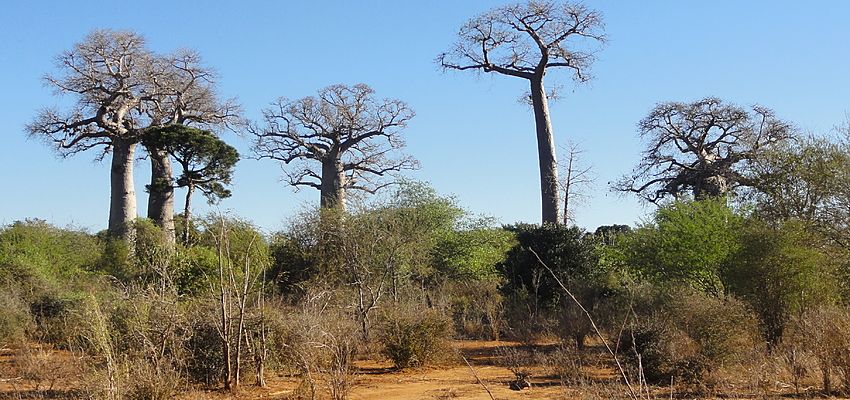


A figure that makes me shudder when I think of Madagascar is the endemic rate of species: plants and animals taken together approaches 84%! More simply, this means that almost everything that you see as living species are only visible here. Of course, this makes the trip unique and justifies any stay in Madagascar. Open your eyes!
Also known as the “Red Island” because of the colour of its soil, Madagascar consists of five distinct climatic and geographical regions.
The central highlands, which contain the capital Antananarivo, cover about 3/4 of the country's area. The average altitude of about 4900 feet above sea level creates a temperate climate there.
The island's north region, whose largest city is Diego Suarez, also has some beautiful mountains (Amber Mountain, Montagne des Français, etc.) and is characterized by an equatorial type of climate. Vegetation is composed of dry and wet forest, rich in biodiversity.
The east coast has a tropical climate. Stretching from the Vanilla Coast in the north to the Taolagnaro area (formerly Fort-Dauphin) in the island's southeast, it is covered with rainforest.
The west coast, which stretches from Mahajanga in the northwest to Morombe in the southwest, has a semi-arid climate, and the vegetation there consists of dry forests and mangrove swamps, which alternate with long sandy beaches and coral reefs.
The southern part of the island, from Toliara to Taolagnaro (formerly Fort-Dauphin), is characterised by a thorny bush type landscape, typical of arid regions. It’s the region of the island that gets the least amount of rainfall, and it is very hot there!

The first image that comes to mind when I imagine Madagascar, of course, is the famous lemurs! The most famous is probably the ring-tailed lemur, which has a black and white ringed tail, making it easy to recognise. It bounces to the side, in a sort of dance that's honestly very funny. But there are more than 100 species of lemurs in Madagascar, and this number increases regularly as new species are discovered by scientists. True ambassadors of the island, they are protected animals who are unfortunately targeted by poachers, for the exotic pet trade or for meat.
Another animal typical of Madagascar is the chameleon. Peering at you with its big independent eyes, it knows how to be discreet when you come close, taking on the colour and texture of the object on which it is located. Unless significant in size - some can reach 24 inches - personally, I can't detect them at first glance... But don't worry, your local guide is used to them and can track them down without upsetting them, for your viewing pleasure!
Also impressive are the humpback whales that come to breed in the calm warm waters of the Mozambique Channel between June and October. You can watch them from a small boat on the island of Sainte Marie, or directly from the beach on the west coast of the island.
If Madagascar's ambassador is the lemur, its emblem is the baobab. Of the 8 species of baobabs found in the world, 7 are found in Madagascar and 6 are endemic there. A mythical tree, the baobab is a tree unlike any other: its branches look like roots, and the first impression is that they have been planted upside-down... Depending on the species, its trunk is smooth and slender and can reach dizzying heights, or it may be rough and stubby. The source of many socio-economic uses by the populations living near them, it also has great cultural significance, reflected by its name - Reniala in Malagasy - which means "Mother of the Forest."
Without a doubt, a tree species that can be very useful is the Ravinala or "Traveller's Tree." This very peculiar shaped tree has the characteristic of saving rainwater at the base of its branches, forming a sort of reservoir from which travellers can drink during their walks in the jungle. Personally, given the condition of the water, often full of mosquitoes and other little beasts, I count on the help of my gourd during my hikes in the jungle...